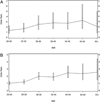The association of increasing body mass index and kidney stone disease
- PMID: 20018330
- PMCID: PMC3375596
- DOI: 10.1016/j.juro.2009.09.085
The association of increasing body mass index and kidney stone disease
Abstract
Purpose: Previous epidemiological works have reported that obesity is a risk factor for kidney stone disease. However, the effect of increasing degrees of obesity on stone formation has yet to be defined. To address this question we examined how an increasing body mass index affects the risk of kidney stone disease.
Materials and methods: We evaluated claims from a 5-year period (2002 to 2006) in a national private insurance database to identify subjects diagnosed with or treated for kidney stones. From a data set of 95,598 patients, subjects were identified by ICD-9 or CPT codes specific to kidney stone disease. Descriptive analyses were performed and odds ratios were calculated.
Results: Gender distribution of the 3,257 stone formers was 42.9% male and 57.1% female. Obesity (body mass index greater than 30 kg/m(2)) was associated with a significantly greater likelihood of being diagnosed with a kidney stone. However, when obese patients were stratified by body mass index there were no significant differences in the likelihood of a kidney stone diagnosis, suggesting a stabilization of risk once body mass index increased above 30 kg/m(2). The association of body mass index and a stone removal procedure was significant only for men and women with a body mass index between 30 and 45 kg/m(2) relative to a body mass index less than 25 kg/m(2) (p <0.001).
Conclusions: An obese body mass index is associated with an increased risk of kidney stone disease. However, the magnitude of this risk appears to be stable in the morbidly obese population. Once body mass index is greater than 30 kg/m(2), further increases do not appear to significantly increase the risk of stone disease.
Copyright 2010 American Urological Association. Published by Elsevier Inc. All rights reserved.
Figures
Comment in
-
Re: The association of increasing body mass index and kidney stone disease. M. J. Semins, A. D. Shore, M. A. Makary, T. Magnuson, R. Johns and B. R. Matlaga. J Urol 2010; 183: 571-575.J Urol. 2011 May;185(5):1984; author reply 1985. doi: 10.1016/j.juro.2010.12.055. J Urol. 2011. PMID: 21439584 No abstract available.
References
-
- Ogden CL, Carroll MD, Curtin LR, et al. Prevalence of overweight and obesity in the United States, 1999–2004. JAMA. 2006;295:1549. - PubMed
-
- Taylor EN, Stampfer MJ, Curhan GC. Obesity, weight gain, and the risk of kidney stones. JAMA. 2005;293:455. - PubMed
-
- Stamatelou KK, Francis ME, Jones CA, et al. Time trends in reported prevalence of kidney stones in the United States, 1976–1994. Kidney Int. 2003;63:1817. - PubMed
-
- Curhan GC, Willett WC, Rimm EB, et al. Body size and risk of kidney stones. J Am Soc Nephrol. 1998;9:1645. - PubMed
-
- Powell CR, Stoller ML, Schwartz BF, et al. Impact of body weight on urinary electrolytes in urinary stone formers. Urology. 2000;55:825. - PubMed


